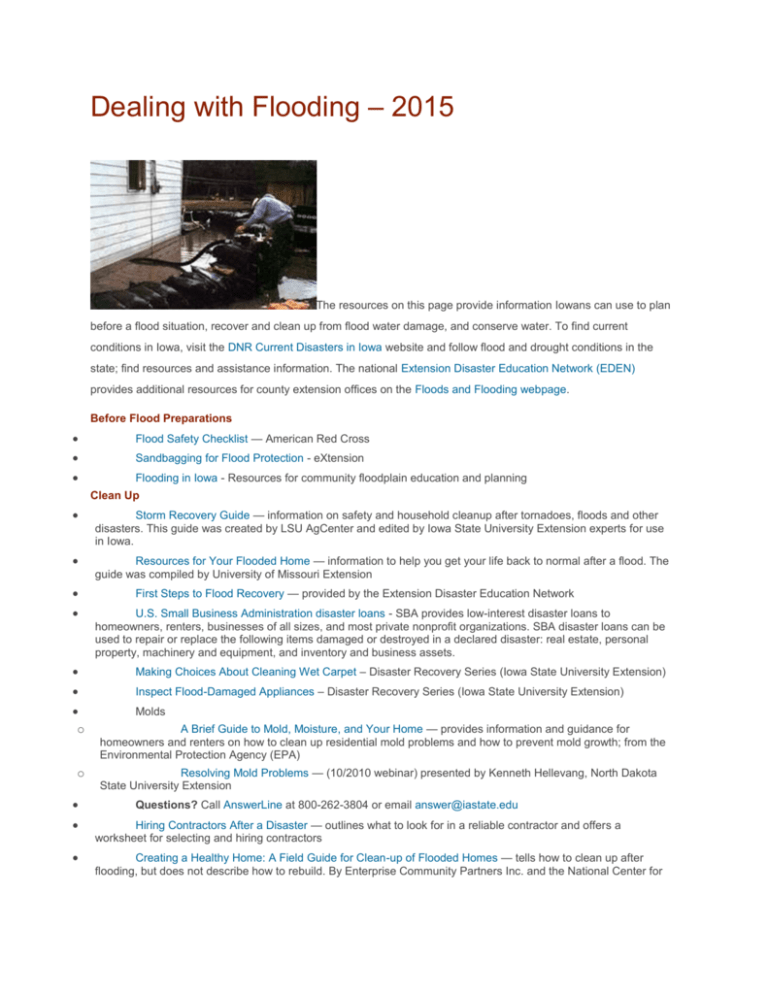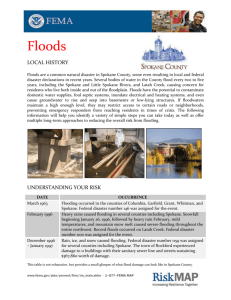Dealing with Flooding - Iowa State University Extension and Outreach
advertisement

Dealing with Flooding – 2015 The resources on this page provide information Iowans can use to plan before a flood situation, recover and clean up from flood water damage, and conserve water. To find current conditions in Iowa, visit the DNR Current Disasters in Iowa website and follow flood and drought conditions in the state; find resources and assistance information. The national Extension Disaster Education Network (EDEN) provides additional resources for county extension offices on the Floods and Flooding webpage. Before Flood Preparations Flood Safety Checklist — American Red Cross Sandbagging for Flood Protection - eXtension Flooding in Iowa - Resources for community floodplain education and planning Clean Up Storm Recovery Guide — information on safety and household cleanup after tornadoes, floods and other disasters. This guide was created by LSU AgCenter and edited by Iowa State University Extension experts for use in Iowa. Resources for Your Flooded Home — information to help you get your life back to normal after a flood. The guide was compiled by University of Missouri Extension First Steps to Flood Recovery — provided by the Extension Disaster Education Network U.S. Small Business Administration disaster loans - SBA provides low-interest disaster loans to homeowners, renters, businesses of all sizes, and most private nonprofit organizations. SBA disaster loans can be used to repair or replace the following items damaged or destroyed in a declared disaster: real estate, personal property, machinery and equipment, and inventory and business assets. Making Choices About Cleaning Wet Carpet – Disaster Recovery Series (Iowa State University Extension) Inspect Flood-Damaged Appliances – Disaster Recovery Series (Iowa State University Extension) o Molds o A Brief Guide to Mold, Moisture, and Your Home — provides information and guidance for homeowners and renters on how to clean up residential mold problems and how to prevent mold growth; from the Environmental Protection Agency (EPA) Resolving Mold Problems — (10/2010 webinar) presented by Kenneth Hellevang, North Dakota State University Extension Questions? Call AnswerLine at 800-262-3804 or email answer@iastate.edu Hiring Contractors After a Disaster — outlines what to look for in a reliable contractor and offers a worksheet for selecting and hiring contractors Creating a Healthy Home: A Field Guide for Clean-up of Flooded Homes — tells how to clean up after flooding, but does not describe how to rebuild. By Enterprise Community Partners Inc. and the National Center for Healthy Housing, this guide is meant for do-it-yourselfers and contractors who need to clean up mold in flooded homes before starting to rebuild or renovate Repairing Your Flooded Home — gives step-by-step advice for clean up, rebuilding and getting help after a flood; by the American Red Cross and the Federal Emergency Management Agency Assessing, Repairing and Rebuilding Basements — a series of ISU Extension publications available to download in PDF format Flood Cleanup: Avoiding Indoor Air Quality Problems — discusses problems caused by microbial growth, as well as other potential effects of flooding, on long-term indoor air quality and the steps you can take to lessen these effects with emphasis on residential flood cleanup Restoring Flooded Buildings: A Homeowner's Next Steps — (10/2011 webinar) presented by Kenneth Hellevang, North Dakota State University Extension Recovery for Home Landscaping — (09/2011) outlines what to consider when beginning the process of recovering trees, shrubs, perennials, lawns and vegetable gardens Crops Forage and Cover Crop Considerations for Delayed Planting and Flooded Sites - July 1, 2014 Delayed and Prevented Planting Provisions — information and decision tool to evaluate planting alternatives Late Planting and Replanting Corn - June 3, 2013 article Flooding Impact and Crop Insurance Frequently Asked Questions - June 2013 Health and Safety Garden Produce in Floods Ticks and Tick-borne Diseases in Iowa Keeping Food and Water Safe After a Disaster or Emergency When the Home Freezer Stops Storm Recovery Guide Questions? Call AnswerLine at 800-262-3804 or email answer@iastate.edu o o Water Conservation Home Water Conservation Tips Farm Water Conservation Fact Sheet Livestock Iowa Beef Center's resources related to flooding and livestock production Private Wells What Should I Do When My Well Floods — Iowa DNR State Hygienic Laboratory at the University of Iowa Stress Management Show You Care By Listening – Disaster Recovery Series, Iowa State University Extension Strengthen Your Relationship in Stressful Times – Disaster Recovery Series, Iowa State University Extension Watching for Stress and What You Can Do: Michael Rosmann, Ag Behavioral Health -video: 26:42 Managing and Coping with Stress — ISU Extension Publications Encouraging Family Communication after a Disaster—from University of Arizona Cooperative Extension Information for family caregivers—from eXtension.org Coping with Stress of Natural Disaster — from Mental Health America After a Natural Disaster: Coping with Loss—from University of Minnesota Extension






